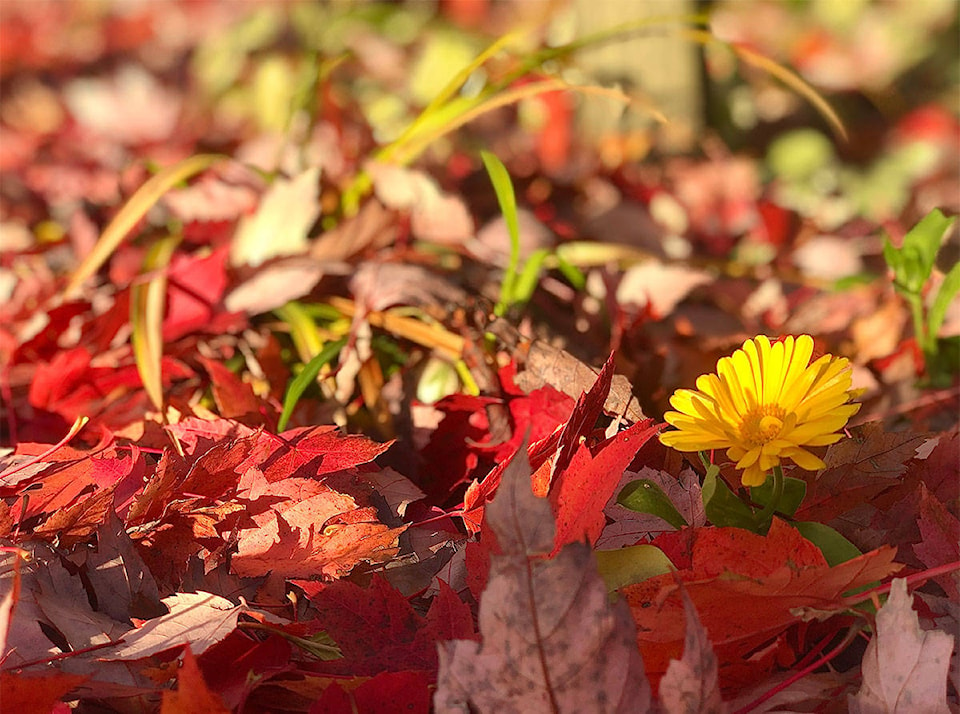Temperatures are plummeting and leaves are falling. They always do.
Yet, before you rake consider this — perhaps it’s better to leave them be.
According to the National Wildlife Federation website, the largest nonprofit educator in the U.S., fallen leaves create their own mini-ecosystem.
Many species live in the leaf layer, including salamanders, chipmunks, frogs, turtles, toads, worms, millipedes and countless insects.
Butterflies and moths overwinter in leaf litter, both types of insects are critical food for birds in the spring when they are feeding their babies.
If you rake up and throw away the leaves, someone might go hungry.
In some places, even bats overwinter in the litter and might not survive the cold temperatures.
READ MORE: Victoria Ballet’s The Nutcracker coming to Revelstoke
For gardeners, leaves are the best. They form a natural mulch that suppresses weeds and also fertilize the soil.
Why spend money on mulch and fertilizer when you can make your own?
There’s the societal expectation to rake lawns, the absurd belief that a tidy lawn means the house and its owner are respectable. It’s all smoke and mirrors.
The same goes for mowing. Nowhere in nature will you find a tidy lawn.
While lawns perform some important ecological functions, like storing carbon and photosynthesis, they are biodiversity barren.
They tend to have only one or two species of grass, that are not even native to Revelstoke. It’s time we move beyond the lawn.
The director of environmental studies at the University of Wisconsin once said in a New York Times article that “the era of the lawn in the west is over.”
According to the Nature Conservancy, roughly 60 per cent of yards in North America are lawns.
One of the best ways to encourage wildflowers, which will support a plethora of insects including bees, is to just leave your lawn to its own devices.
Yes, yes, that means the weeds will grow. But, do you know what a weed is? It’s a plant growing where it shouldn’t be, at least according to humans.
Shift your perspective slightly and as the Guardian newspaper once wrote, “…like a botanical version of the ugly duckling story, many of these so-called weeds will grow into lovely wildflowers.”
With neglect, your barren lawn can become a mini-meadow. Of course, gardens can’t substitute wild meadows or grasslands.
READ MORE: ‘I’ve got great survival instinct’: Big Eddy fire victim draws on past trauma for strength
While Revelstoke does not have grassland habitat, which is located in the prairies, wild grasslands are among the most endangered ecosystems in the world with less than 25 per cent remaining, meaning a higher proportion grassland habitat has been lost then the Brazilian Rainforest.
Canada’s grasslands support fishes, waterfowl and millions of birds as they stop to rest and feed during their migration to the boreal and Arctic.
Most of the grasslands have been lost to agriculture and urban sprawl.
From 1990 to 2015 in Saskatchewan alone, more than 3.3 million acres of native grassland were lost, which is roughly the size of The Bahamas.
According to Nature Canada, less than one per cent of native grasslands in Saskatchewan and Alberta are protected.
While the lawns of Revelstoke are a far cry from prairie grasslands, perhaps we don’t need any more artificial habitat.
Next spring, consider letting your lawn grow wild and free.
@pointypeak701
liam.harrap@revelstokereview.com
Like us on Facebook and follow us on Twitter.
